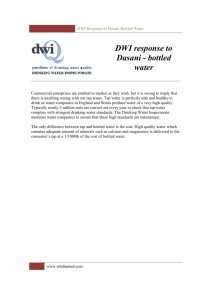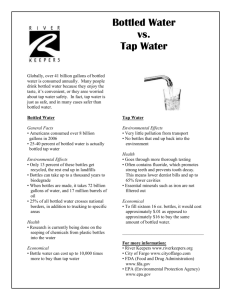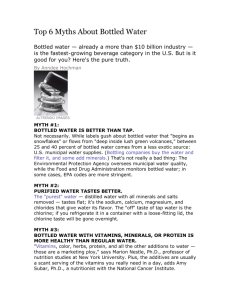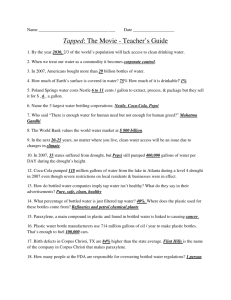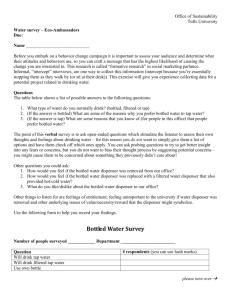Clean, Crisp Water Bottled Water Versus Tap Water
advertisement
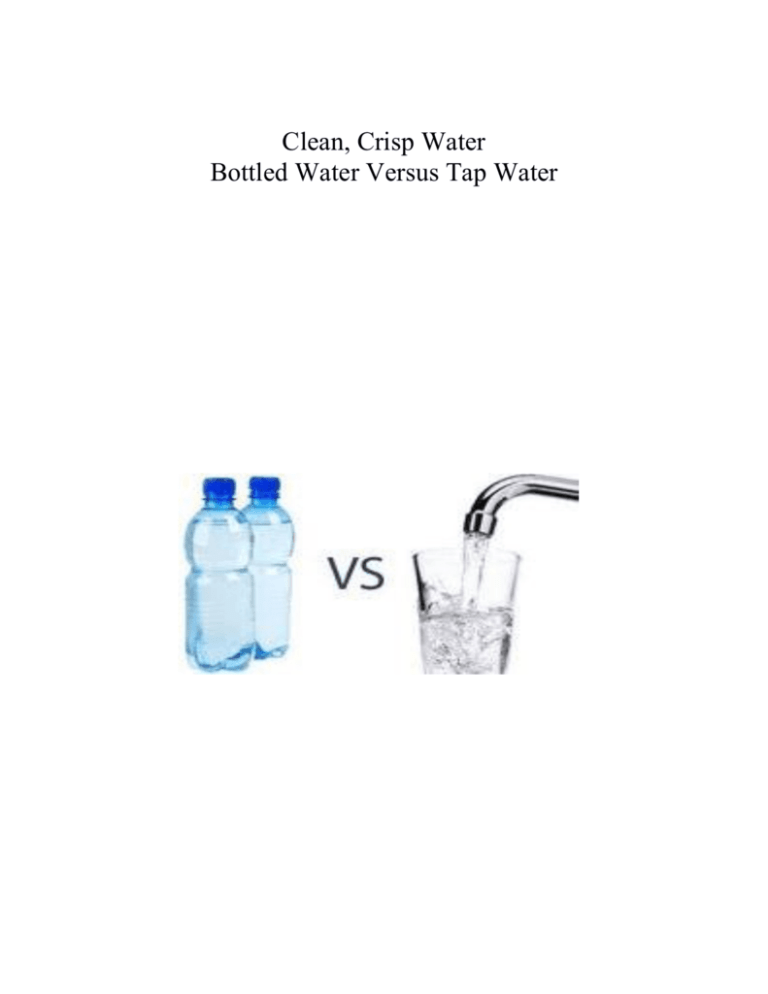
Clean, Crisp Water Bottled Water Versus Tap Water Bottled water is a popular beverage around the world, and consumption has grown steadily in recent years. However, even with its steady growth and popularity, bottled water is not without controversy. Since the early 90's Canadians consumption of bottled water has continued to rise. In 2005 Canadians spent $652.7 million on bottled water and consumed 1.9 billion litres. Some people choose bottle water because they think that it is safer than tap water, but there is no evidence to support this. 25% of bottled water is originated from municipal water resources. The type of water people consume has environmental, social, financial, and health impacts. Lets see how bottled water and tap water line up against each other. Convenience: < < One important reason consumers choose bottled water over tap water is convenience. Bottled water is packaged in lightweight plastic containers that are significantly less weighty than reusable metal or plastic bottles. Consumers can purchase bottled water when they are ready to consume it and then discard the bottle immediately afterward, thereby eliminating the need to carry it around. Bottled water is also readily available from public vendors such as restaurants, convenience stores, gift shops, vending machines, and street cars, while drinking fountains or public taps are not always available or working properly. Regulation of the Bottled Water Industry: < < < < Regulating the quality of bottled water is complicated. From origin to consumption, bottled water undergoes a multi-step process. Bottled water in Canada is considered a food product under the Food and Drugs Act and Regulations (FDA). The government regulatory oversight that exists now has not been updated since 1973, with some minor changes made in the early 1980's. Other regulation of the bottled water industry is largely a volunteer process overseen by the industry. It is estimated that Canadian bottling plants receive government inspections once, on average every 3 - 5 years. There have been 29 recalls of 49 bottled water products since 2000 by the Canadian Food Inspection Agency, 5 of which have been made public and were recalled due to bacterial or chemical contaminants. Regulation of Tap Water: < < < < In Canada, the quality and safety of tap water is primarily a provincial/territorial or municipal responsibility. There are also federal Guidelines for Canadian Drinking Water Quality which set Maximum Allowable Concentrations for microbiological, chemical and radiological substances found in water that are known or thought to be harmful to human health. Municipal tap water is regulated by the Environmental Protection Agency (EPA) and requires cities to filter and disinfect it according to strict standards. Chlorine is one of the most common reasons why people choose to filter, purify their drinking water, or buy bottled water. Although chlorination of municipal water supplies is done in the interest of public safety, this method of eliminating harmful bacteria can also leave the water with an unpleasant taste and smell. The city of Ottawa conducts over 125,000 tests per year and the city of Toronto checks water for bacteria every 4 to 6 hours. < Tap water goes through a rigorous process of cleaning, filtering and testing and is infused with fluoride to aid in the reduction of tooth decay. Cost: < < Bottled water can be an affordable option when compared to other prepared beverages. But it is far more expensive than tap water ~ as much as 10,000 times more. The cost of bottled water calculates to several times more per gallon than for gasoline. Water from public taps and drinking fountains, on the other hand is free to the public. Environment: < < < < The main advantage of tap water is that it uses no packaging, so no effect on the environment. Bottled water is a different story, the 31.2 billion litres of bottled water consumed annually in the United States, uses more than 17 million barrels of oil to produce the plastic bottles. When considering the life cycle of a bottle water, its energy cost are the equivalent, on average, to filling up a quarter of each bottle with oil. According to one report, 235,086 tons of plastic bottles were generated and approximately 84,744 tons were recovered and recycled in 2002. Canadian provinces with deposit return programs have much higher recycling rates. The average recovery rate (2002) for beverage bottles in non-deposit programs was 33 %, compared with an average of 75% where these programs are in place. Used water bottles tend to end up in landfills and account for 1.5 million tons of plastic waste a year. Information gathered from: http://www.bottledwaterfreeday.ca/index2.php?section_id=18, http://www.ehow.com/info_8222111_pros-water-vs-tap-water.html http://www.nrdc.org/water/drinking/bw/bwinx.asp Why People Drink Bottled Water Over Tap Water North America is the second highest country for sales of Bottled Water Clean, Crisp Water, Bottled Water VS Tap Water 1) What percent of bottled water originates from municipal water resource? A) 13% B) 25% C) 20% D) 30% 2) People choose to purchase bottled water because? A) It’s readily available B) Convenience C) Tap water has a chlorine taste to it D) All of the above 3) Tap water is regulated by? A) Food and Drug Act (FDA) B) Guidelines for Canadian Drinking Water C) Environmental Protection Act (EPA) D) Canadian Food Inspection Agency 4) North America is the _______ highest country for sales of bottled water? A) 2 nd B) 4 th C) 1 st D) 3 rd 5) Used water bottles tend to end up in landfills and account for __________ tons of plastic waste a year? A) 2 million B) 5 million C) 1.5 million D) 8 million Answers to Quiz 1) B 2) D 3) C 4) A 5) C
